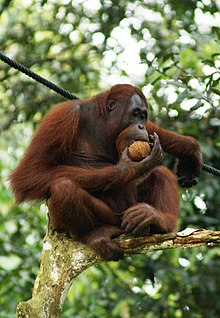Ponginae
| Ponginae Temporal range: [citation needed]
| |
|---|---|

| |
| Pongo pygmaeus (Bornean orangutan) | |
| Scientific classification | |
| Domain: | Eukaryota |
| Kingdom: | Animalia |
| Phylum: | Chordata |
| Class: | Mammalia |
| Order: | Primates |
| Suborder: | Haplorhini |
| Infraorder: | Simiiformes |
| Family: | Hominidae |
| Subfamily: | Ponginae Elliot, 1913 |
| Type genus | |
| Pongo Lacépède, 1799
| |
| Genera | |
|
†Lufengpithecus | |
Ponginae /pɒnˈdʒaɪniː/, also known as the Asian hominids, is a subfamily in the family Hominidae. Once a diverse lineage of Eurasian apes, the subfamily has only one extant genus, Pongo (orangutans), which contains three extant species; the Sumatran orangutan (Pongo abelii), the Tapanuli orangutan (Pongo tapanuliensis) and the Bornean orangutan (Pongo pygmaeus). All three species are listed as critically endangered by the International Union for Conservation of Nature (IUCN).[1][2][3]
Evolutionary history
[edit]The first pongine genera appear in the Miocene, Sivapithecus and Khoratpithecus,[4][5] six or seven million years before evidence of orangutans was found from Pleistocene southeast Asia and southern China.[6] Ponginae may also include the genera Lufengpithecus, Ankarapithecus, and Gigantopithecus. However, phylogenetic analysis in 2004, which originally found Lufengpithecus and Ankarapithecus to be most closely related to the orangutan, gave different results "under an analytical method that attempted to reduce stratigraphic incongruence",[7] instead placing them on the base of the stem of the African ape-human clade.[4]
Meganthropus was considered by the majority of paleoanthropologists as falling within the variation of Homo erectus. However, a study from 2019 of tooth morphology found Meganthropus a valid genus of non-hominin hominid ape, most closely related to Lufengpithecus[8]
The most well-known fossil genus of Ponginae is Sivapithecus, consisting of several species from 12.5 million to 8.5 million years ago. It differs from orangutans in dentition and postcranial morphology.[7]
Taxonomy
[edit]Ponginae[9]
- †Lufengpithecini
- †Lufengpithecus
- Lufengpithecus lufengensis
- Lufengpithecus keiyuanensis
- Lufengpithecus hudienensis
- †Meganthropus
- Meganthropus palaeojavanicus
- †Lufengpithecus
- †Sivapithecini
- †Ankarapithecus[failed verification]
- Ankarapithecus meteai
- †Sivapithecus
- Sivapithecus parvada
- Sivapithecus sivalensis
- Sivapithecus indicus
- †Gigantopithecus
- Gigantopithecus bilaspurensis
- Gigantopithecus blacki
- †Indopithecus
- Indopithecus giganteus
- †Ankarapithecus[failed verification]
- Pongini
- †Khoratpithecus
- Pongo (orangutans)
- †Pongo hooijeri
- †Pongo weidenreichi
- Sumatran orangutan, Pongo abelii
- Bornean orangutan, Pongo pygmaeus
- Tapanuli orangutan, Pongo tapanuliensis
References
[edit]- ^ Singleton, Ian; Wich, Serge A.; Nowak, Matthew G.; Usher, Graham; Utami-Atmoko, Sri Suchi (2017). "Pongo abelii". IUCN Red List of Threatened Species. 2017.3. 2017: e.T121097935A115575085. doi:10.2305/IUCN.UK.2017-3.RLTS.T121097935A115575085.en.
- ^ Ancrenaz, Mark; Gumal, M.; Marshall, Andrew; Meijaard, Erik; Wich, Serge A.; Hussons, Steve J. (2016). "Pongo pygmaeus". IUCN Red List of Threatened Species. 2016.1. 2016: e.T17975A17966347. doi:10.2305/IUCN.UK.2016-1.RLTS.T17975A17966347.en.
- ^ Nowak, Matthew G.; Rianti, Puji; Wich, Serge A.; Meijaard, Erik; Fredriksson, Gabriella (2017). "Pongo tapanuliensis". IUCN Red List of Threatened Species. 2017.3. 2017: e.T120588639A120588662. doi:10.2305/IUCN.UK.2017-3.RLTS.T120588639A120588662.en.
- ^ a b Finarelli, J. A.; Clyde, W. C. (2004). "Reassessing hominoid phylogeny: Evaluating congruence in the morphological and temporal data" (PDF). Paleobiology. 30 (4): 614. Bibcode:2004Pbio...30..614F. doi:10.1666/0094-8373(2004)030<0614:RHPECI>2.0.CO;2. S2CID 86034107. Archived from the original (PDF) on 2010-07-21. Retrieved 2015-09-03.
- ^ Chaimanee, Y.; Suteethorn, V.; Jintasakul, P.; Vidthayanon, C.; Marandat, B.; Jaeger, J. J. (2004). "A new orang-utan relative from the Late Miocene of Thailand" (PDF). Nature. 427 (6973): 439–441. Bibcode:2004Natur.427..439C. doi:10.1038/nature02245. PMID 14749830. S2CID 4349664. Archived from the original (PDF) on 2012-01-17.
- ^ Bacon, A. M.; The Long, V. (2001). "The first discovery of a complete skeleton of a fossil orang-utan in a cave of the Hoa Binh Province, Vietnam". Journal of Human Evolution. 41 (3): 227–241. Bibcode:2001JHumE..41..227B. doi:10.1006/jhev.2001.0496. PMID 11535001.
- ^ a b Taylor, C. (2011). "Old men of the woods". Palaeos. Retrieved 2013-04-04.
- ^ Zanolli, Clément; Kullmer, Ottmar; Kelley, Jay; Bacon, Anne-Marie; Demeter, Fabrice; Dumoncel, Jean; Fiorenza, Luca; Grine, Frederick E.; Hublin, Jean-Jacques; Nguyen, Anh Tuan; Nguyen, Thi Mai Huong (May 2019). "Evidence for increased hominid diversity in the Early to Middle Pleistocene of Indonesia". Nature Ecology & Evolution. 3 (5): 755–764. Bibcode:2019NatEE...3..755Z. doi:10.1038/s41559-019-0860-z. ISSN 2397-334X. PMID 30962558. S2CID 102353734.
- ^ Haaramo, Mikko (2004-02-04). "Pongidae". Mikko's Phylogeny Archive. after Begun, 2002, Chaimanee et al., 2003 and Chaimanee et al., 2004.




